| Article ID | Journal | Published Year | Pages | File Type |
|---|---|---|---|---|
| 1718840 | Aerospace Science and Technology | 2007 | 9 Pages |
Induced swirl flow has proved to be an effective way of increasing the residence time of oxidizer in the solid fuel of hybrid rocket motor. For the present study, both experimental and numerical studies have been conducted in order to investigate the effect of both swirl injector and helical configuration of the grain (represented by a pitch number) on the enhancement of regression rate. The results showed that a higher regression rate can be achieved in the case of pitch 6 than in the case of pitch 100 when either no swirl or substantially strong swirl is imposed at the inlet. However, the regression rate in the case of pitch 100 showed even further increase than as observed in pitch 6 if a moderate strength of swirl is imposed. This is believed not only due to an increase in residence time of oxidizer flow but also due to modified flow structures resulted from the interaction of the inlet swirl and the geometric configuration of pitch 100. Thus, it was concluded that a proper combination of helical configuration with large pitch number and a moderate inlet swirl can produce the condition for achieving the maximum regression rate. Numerical calculations with RANS type turbulence model supported the experimental findings that the pitch 100 is more effective in maintaining the rotational component of momentum flux all the way up to the port exit than the pitch 6 when a swirl is imposed. Also calculation result suggests that a less pressure drop is involved in the pitch 100. Nevertheless, more detailed flow information such as turbulence statistics and residence time will be required for the better understanding of the role of swirl and helical configuration and, thus, it would be desirable to perform a DNS or LES type computation.
